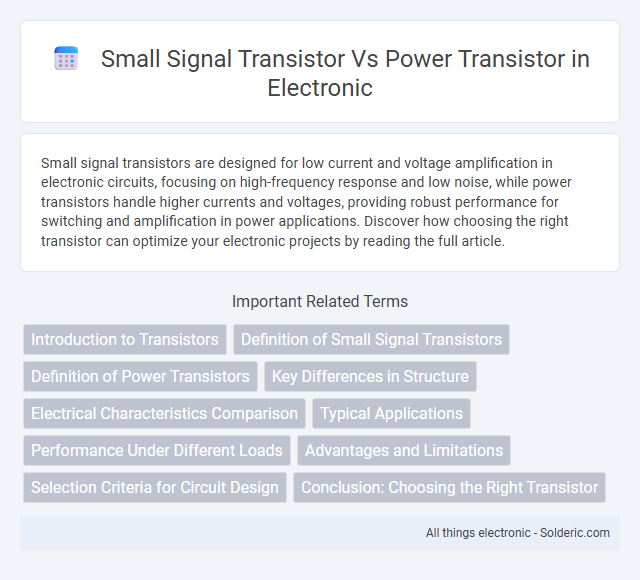Small signal transistors are designed for low current and voltage amplification in electronic circuits, focusing on high-frequency response and low noise, while power transistors handle higher currents and voltages, providing robust performance for switching and amplification in power applications. Discover how choosing the right transistor can optimize your electronic projects by reading the full article.
Comparison Table
| Feature | Small Signal Transistor | Power Transistor |
|---|---|---|
| Purpose | Amplify low-level signals | Handle high current and voltage |
| Current Handling | Low (mA range) | High (A range) |
| Voltage Rating | Typically low (up to ~100V) | High (up to several hundred volts) |
| Power Dissipation | Low (mW to W range) | High (tens to hundreds of watts) |
| Package Size | Small, compact | Large, with heat sinks |
| Switching Speed | Fast | Slower compared to small signal |
| Typical Applications | Signal amplification, RF circuits | Power amplification, motor control |
| Cost | Lower | Higher |
Introduction to Transistors
Small signal transistors are designed for low current and voltage applications, primarily used in signal amplification and switching within electronic circuits. Power transistors handle high current and voltage loads, making them essential for power regulation, motor control, and audio amplification. Understanding the differences between these transistor types ensures you select the right component for your specific electronic project needs.
Definition of Small Signal Transistors
Small signal transistors are semiconductor devices designed to amplify low-level signals in electronic circuits, primarily handling small currents and voltages. Unlike power transistors, which manage high current and voltage for driving heavy loads, small signal transistors are used in applications such as signal processing, amplification in radios, and other low-power devices. Understanding the definition of small signal transistors helps you select the appropriate component for precise and efficient low-signal amplification needs.
Definition of Power Transistors
Power transistors are semiconductor devices designed to handle high voltage and current levels, making them suitable for amplifying or switching substantial power in electronic circuits. They possess larger junction areas and enhanced heat dissipation features compared to small signal transistors, enabling efficient management of thermal stress. These transistors are commonly used in power supplies, motor control, and audio amplification applications where robust performance under heavy electrical loads is required.
Key Differences in Structure
Small signal transistors feature a compact structure with thin semiconductor layers designed to handle low current and voltage applications, enabling high-frequency performance and amplification of weak signals. Power transistors possess a robust, thicker semiconductor construction with enhanced heat dissipation capabilities to manage high current, voltage, and power levels in switching and amplification tasks. The structural differences impact their thermal resistance, switching speed, and maximum power ratings, making each type suited for specific electronic circuit roles.
Electrical Characteristics Comparison
Small signal transistors are designed to amplify low-level signals and typically operate at lower currents (milliamps) and voltages (below 100V), exhibiting high gain and fast switching speeds ideal for radio frequency and signal processing applications. Power transistors handle higher currents (up to tens or hundreds of amps) and voltages (up to several hundred volts), focusing on robustness, heat dissipation, and efficiency to drive motors, power supplies, and amplifiers. Your selection should consider the transistor's maximum collector current (Ic), voltage rating (Vce), gain (hFE), and switching speed to match your specific electrical requirements.
Typical Applications
Small signal transistors are commonly used in low-power amplification, switching, and signal processing tasks within radios, audio equipment, and sensor circuits. Power transistors handle high current and voltage loads, making them ideal for applications like motor drives, power supplies, and audio amplifiers. Your choice between these transistors depends on the required power handling and application-specific performance.
Performance Under Different Loads
Small signal transistors excel in performance with low current and voltage loads, making them ideal for amplification in audio and signal processing circuits. Power transistors handle significantly higher currents and voltages, allowing Your designs to drive heavy loads like motors and power supplies efficiently without thermal breakdown. Their distinct load-handling capabilities influence their application in electronics, ensuring optimal performance under specified load conditions.
Advantages and Limitations
Small signal transistors offer advantages such as high-frequency response, low noise, and efficient amplification in low-power applications, making them ideal for signal processing and switching. Power transistors excel in handling high voltage and current levels with robust thermal management but face limitations including slower switching speeds and larger physical size. The choice between small signal and power transistors depends on specific needs for amplification, power capacity, and thermal dissipation in electronic circuits.
Selection Criteria for Circuit Design
Selection criteria for small signal transistors in circuit design prioritize low noise, high gain, and fast switching capabilities, making them ideal for amplification and signal processing tasks. Power transistors are selected based on high current and voltage ratings, thermal stability, and robust packaging to handle large power dissipation in applications such as motor control and power regulation. Designers must assess parameters like maximum collector current (Ic), power dissipation (Pd), gain bandwidth product (fT), and thermal resistance to ensure reliable performance under specific operating conditions.
Conclusion: Choosing the Right Transistor
Small signal transistors excel in handling low currents and high-frequency signals, making them ideal for amplification and switching in electronic circuits. Power transistors are designed to manage high currents and dissipate significant power, suited for driving motors, power supplies, and high-load applications. Selecting the right transistor depends on the application's current, voltage, frequency requirements, and thermal management considerations.
Small signal transistor vs Power transistor Infographic

 solderic.com
solderic.com